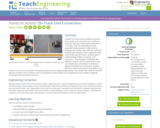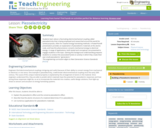
Listen and view examples of unit conversions and unit analysis. Examine English to Metric and Metric to Metric conversion examples.
- Subject:
- Science
- Material Type:
- Textbook
- Provider:
- Chiral Publishing
- Date Added:
- 10/03/2023

Listen and view examples of unit conversions and unit analysis. Examine English to Metric and Metric to Metric conversion examples.
![An Introduction to Chemistry: Unit Conversions [PDF]](https://openspace.infohio.org/static/newdesign/images/materials/default-thumbnail-index.png)
Read and learn about the unit conversion analysis step and English-Metric conversion factors. Learn the steps to rounding answers from division and multiplication problems and formulas for temperature and density conversions.
![An Introduction to Chemistry: Unit Conversions: Study Guide [PDF]](https://openspace.infohio.org/static/newdesign/images/materials/default-thumbnail-index.png)
Test your knowledge and understanding on unit conversions by completing this study guide. Review topics such as temperature conversions, density conversions, density calculations, and rounding unit conversions.

This Washington State University site provides a wonderful source for all the literary movements that have taken place in American Literature from 1620-1920. Click on the movement (listed on the left)you are interested in (Naturalism, Realism, Transcendentalism, etc.) and information will be provided on the definition, characteristics, practitioners, and context and controversy of each movement.

Fractions and Decimals
Type of Unit: Concept
Prior Knowledge
Students should be able to:
Multiply and divide whole numbers and decimals.
Multiply a fraction by a whole number.
Multiply a fraction by another fraction.
Write fractions in equivalent forms, including converting between improper fractions and mixed numbers.
Understand the meaning and structure of decimal numbers.
Lesson Flow
This unit extends students’ learning from Grade 5 about operations with fractions and decimals.
The first lesson informally introduces the idea of dividing a fraction by a fraction. Students are challenged to figure out how many times a 14-cup measuring cup must be filled to measure the ingredients in a recipe. Students use a variety of methods, including adding 14 repeatedly until the sum is the desired amount, and drawing a model. In Lesson 2, students focus on dividing a fraction by a whole number. They make a model of the fraction—an area model, bar model, number line, or some other model—and then divide the model into whole numbers of groups. Students also work without a model by looking at the inverse relationship between division and multiplication. Students explore methods for dividing a whole number by a fraction in Lesson 3, for dividing a fraction by a unit fraction in Lesson 4, and for dividing a fraction by another fraction in Lesson 6. Students examine several methods and models for solving such problems, and use models to solve similar problems.
Students apply their learning to real-world contexts in Lesson 6 as they solve word problems that require dividing and multiplying mixed numbers. Lesson 7 is a Gallery lesson in which students choose from a number of problems that reinforce their learning from the previous lessons.
Students review the standard long-division algorithm for dividing whole numbers in Lesson 8. They discuss the different ways that an answer to a whole number division problem can be expressed (as a whole number plus a remainder, as a mixed number, or as a decimal). Students then solve a series of real-world problems that require the same whole number division operation, but have different answers because of how the remainder is interpreted.
Students focus on decimal operations in Lessons 9 and 10. In Lesson 9, they review addition, subtraction, multiplication, and division with decimals. They solve decimal problems using mental math, and then work on a card sort activity in which they must match problems with diagram and solution cards. In Lesson 10, students review the algorithms for the four basic decimal operations, and use estimation or other methods to place the decimal points in products and quotients. They solve multistep word problems involving decimal operations.
In Lesson 11, students explore whether multiplication always results in a greater number and whether division always results in a smaller number. They work on a Self Check problem in which they apply what they have learned to a real-world problem. Students consolidate their learning in Lesson 12 by critiquing and improving their work on the Self Check problem from the previous lesson. The unit ends with a second set of Gallery problems that students complete over two lessons.

Convert customary units of measure by dividing when converting from small units to large units.
A free CK-12 account is required to view all materials.

Download these free worksheets to sharpen your measurement skills. Sheets focus on temperature, conversion, area and perimeter, volume, and more.

Use this converter to find equivalent units for a measure. You can convert measures for area, length, weight, temperature, and volume.

Students use three tracks marked on the floor, one in yards, one in feet and one in inches. As they start and stop a robot specific distances on a "runway," they can easily determine the equivalent measurements in other units by looking at the nearby tracks. With this visual and physical representation of the magnitude of the units of feet, yard and inches, students gain an understanding of what is meant by "unit conversion." They also gain a familiarity with different common units of measurement. They use multiplication and division to verify their physical estimated unit conversions. Students also learn about how common and helpful it is to convert from one unit to another in everyday situations and for engineering purposes. This activity helps students make the abstract concept of unit conversion real so they develop mental models of the magnitude of units instead of applying memorized conversion factors by rote.

Students learn about a fascinating electromechanical coupling called piezoelectricity that is being employed and researched around the world for varied purposes, often for creative energy harvesting methods. A PowerPoint(TM) presentation provides an explanation of piezoelectric materials at the atomic scale, and how this phenomenon converts mechanical energy to electrical energy. A range of applications, both tested and conceptual, are presented to engage students in the topic. Gaining this background understanding prepares students to conduct the associated hands-on activity in which they create their own small piezoelectric "generators."

Express a degree measurement in radians.
A free CK-12 account is required to view all materials.

This site from the University of Utah provides a good simple base conversion page.

Learn the process of turning a repeating decimal into a fraction. [5:08]

Students are introduced to the nano-size length scale as they make measurements and calculate unit conversions. They measure common objects and convert their units to nanometers, giving them a simple reference frame for understanding the very small size of nanometers. Then, they compare provided length data from objects too small to measure, such as a human hair and a flea, giving them a comparative insight to the nanotechnology scale. Using familiar and common objects for comparison helps students understand more complex scientific concepts.

Do you need a quick conversion from metric units to imperial units or just the reverse? Use this resource for conversions of length, weight, pressure, and volume.